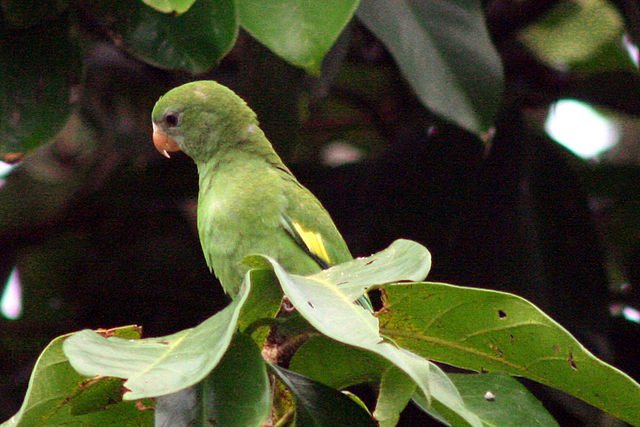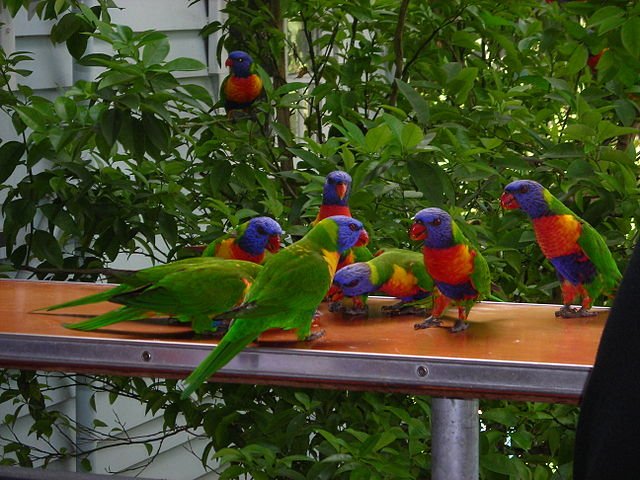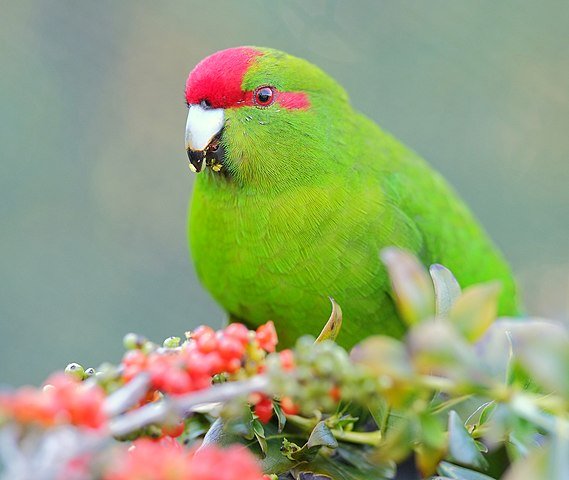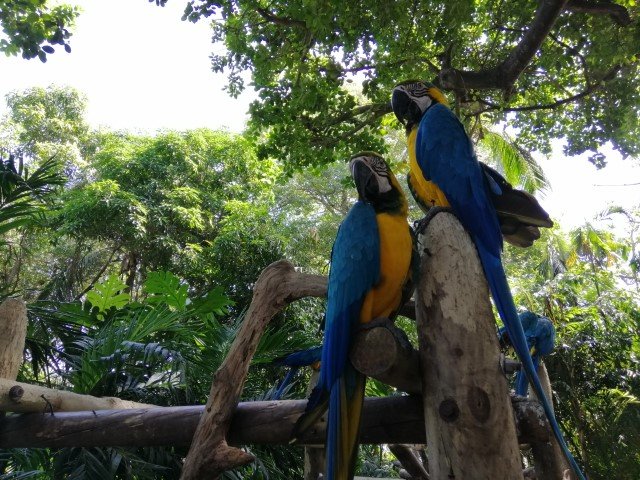Fondly and famously known as Bee Parrots, Canary-winged or White-winged Parakeet are native to the Amazon River basin and can be found extensively throughout the whole of South America. Inhabiting southeastern regions of Colombia to Brazil’s river mouth, they love to dwell in the savannahs, open forests, river islands, and seasonally waterlogged forest areas. However, the bird tends to avoid dense tropical forests.
The decline in their popularity led to many caged birds being set free in many parts of the United States like Miami, San Francisco, Lima, Los Angeles including Puerto Rico. Initially, the Bee Bee parrots’ populations self-sustained but only until recently when their populations started decreasing. Now they are hardly found in large numbers except in their native areas.
Bee Bee Parrot Lifespan
In the wild, the Bee Bee lifespan averages around 10 years which is not much different than what they live for while in captivity. That said, they still tend to live less in the wild. The major reason for this is the non-availability of this bird’s suitable living conditions. Even the feral population of the Bee Bee could hardly survive a few generations in the urban areas or surrounding them.
Bee Bee’s lifespan in captivity averages more than that of their wild counterparts courtesy the special care tended to their diet and living conditions. They can live for around 15 years inside homes.
Bee Bee Parrot Colors
Bee Bee parrots are mostly green in color with a few color variations around the same color palette. The head is green but the forehead and face have a little bluish tinge. One can easily spot a few grayish-blue feathers on the face. The color of the eyes are dark brown and the bird has a pale gray ring around them. The bill is horn-colored with a pale-orange wash over it. Feet and legs are also of the same pale orangish-gray color.
The species has a yellow trail on the edges of his folded wings. But the most striking feature is the white patches on the wings that are better seen when the bird is flying. This very distinction of Canary-winged has helped experts distinguish him from a very similar species known as the Yellow-Chevroned Parakeet. Barring the white wing patches, the almost similar color and markings of both the birds have made experts think them conspecific for a long time in the past. This has made the Bee Bee ‘s name changed from Canary-Winged to White-Winged Parakeet.
Bee Bee Parrot Gender Differences
Bee Bee parrots are monomorphic and both the sexes are difficult to distinguish between. That said, there can still be some minor differences between both the sexes that give a vague idea about the gender of the bird.
Bee Bee Parrot Size
Though very little, size does play a role in identifying bee bees’ gender. Where the cocks size averages around 9.5 inches, their female counterparts are slightly smaller in size, roughly at around 8.5 inches only.
Bee Bee Parrot Weight
The Bee Bee males are generally heavier than their partners. Where males weigh around 75 grams, the females weigh around 65 grams.
Best way to Sex Bee Bee Parrot
The best way to know the gender of the bird is DNA Sexing. This is the safest and the most-technologically advanced sexing technique developed so far. With 100% accuracy, it doesn’t rely on the guessing method used in the visual sexing of the bee bees.
One clinic that does bird sexing. Their website ordering page says DNA sexing costs $19.00 – $23.00. We are not affiliated with any of DNA sexing centers, and you can find many more just using google 🙂
https://dnacenter.com/testing-pets-vets/bird-dna-testing/
Bee Bee Parrot Behavior
Playful
The bee bees have quite a colorful personality which makes them extremely playful and chirpy. To keep them entertained, they need to be given a lot of toys or ways of entertainment. These little birds keep themselves and others around entertained with their cute tricks.
Energetic
Their inherent nature of jumping from branch to branch in the wild has made these birds naturally energetic. And they stay loyal to their energy levels in captivity too. To channelize their energies, it is advised to add a few perches to their cage. It is best to keep the size and width of the perches varied for optimum muscles flexing of the bird.
Cuddly
Bee Bee parrots are extremely cuddly and love to snuggle with their favorite human. One can often find them digging into their owner’s shoulders’ or snuggle up to the cushions or pillows to have a sense of security.
Jealous
These birds are infamous for getting jealous of anyone getting close to their favorite human. There have been instances where these little birds have attacked the other cuddly pets or children of the family. That said, their small size has done more damage to themselves only in retaliation than otherwise. The best sign to know that the bird is getting pressed from the proximity of his owner with someone is their wing raising and subsequent flapping giving explosive sound.
Bee Bee Parrot Breeding
To know about the breeding of Bee Bee parrots, Let’s go through all the aspects involved:
Bee Bee Parrot Nesting Requirements
Bee Bees are cavity dwellers. They make burrows inside termite holes to customize them as per their requirements. The purpose is to have a snug-fit nest that is also big enough for the pair and the chicks.
For the cage dwellers, add a nesting box to encourage breeding behavior. Attach a snug-fit nest box to the rear end of his daily cage. Attaching it in the front would take away the much-needed privacy during breeding. Line this nest box with organic wood shavings to add warmth to it.
Bee Bee Parrot Breeding Season
Bee bees are naturally inclined to breed during the wet months of the year. In their native areas, they usually breed from January to July.
Bee bee Parrot Egg-Laying
The female bee bees lay a clutch every season. Each clutch has 3-5 white eggs. The hen incubates the eggs solely for around 26 days. In the meantime, the male takes care of the hen and might help in incubation in the night.
Once the young ones are hatched, both the parents rear the young ones. The chicks fledge at around 7 weeks old.
Bee Bee Parrot Diet
White-winged parrot’s diet varies with his habitat. Their diet profile in the wild and captivity is:
Bee Bee Parrot Diet in the Wild
Fond of seeds in the wild, the diet of the bee bees is a little diverse in the wild. They also love feeding on both nectar, gum, and seeds of native plants. Gorging on fights and berries are their preferred meals at any time. They supplement their diet with a few insects or their larvae throughout the day. They are also famed to visit riversides or such areas where mineral-rich soil is in abundance.
Bee Bee Parrot Diet in Captivity
Bee bees as pets are usually offered an almost similar kind of diet as they feed on in the wild. Many pet owners try to supplement their meals with mineral blocks to cover up their need for feeding on mineral-rich soil. This practice has recently helped in increasing their adoption as they have a better survival rate in captivity now.
Seeds retain the spot of favorite-food of Bee Bees in captivity too. And these little birds have a special love for the sprouted ones. A mix of millets, quinoa, oats, safflower can be served. Serve them only one or two tablespoons. Avoid feeding them the market-made seed-mix.
Offer them a bowl of fresh fruits on a typical day. Serve them mangoes, pomegranates, strawberries, apples, bananas, blueberries, pineapples. If possible, add their favorite figs or berries.
Feed them pellets for a balanced nutrition profile. Choose a high-quality trusted brand.
Add some vegetables, especially green leafy ones to make his diet wholesome. Collard greens, kale greens, green beans, and watercress are his favorites. Add a few leaves of spinach or broccoli to fulfill his daily calcium requirements. Additionally, add slices of winter squash, pumpkins, or sweet potatoes for the Vitamin A fix.
Cuttlebones are a must to renew Bee Bee’s calcium reserves. The best way is to hang the cuttlebone inside his cage for the bird to chew.
For keeping the Bee Bees hydrated, freshwater is a must. Keep a feeding bowl filled with water inside the bird’s cage all the time. For hotter times, keep two bowls as a backup. The water must be of drinkable quality. Keep changing the water of the bowl to maintain hygiene.
Summing Up
Bee Bee parrots aren’t very popular as pets. They have been tagged as jealous and untalented. Like other few pet parrots, they lack great talking or intellectual abilities. That said, they can entertain everyone around with their mimicry and whispering skills. They are quite an adaptive species and do not ask for any special attention or diet to stay happy. Just a few snuggles into his favorite human’s pockets or hair, and they are more than happy. And for their longevity, offer them a healthy diet for physical fitness and their favorite seeds, mineral blocks, and treats for their mental wellbeing.
Featured Photo credit: anthrotect / CC BY



